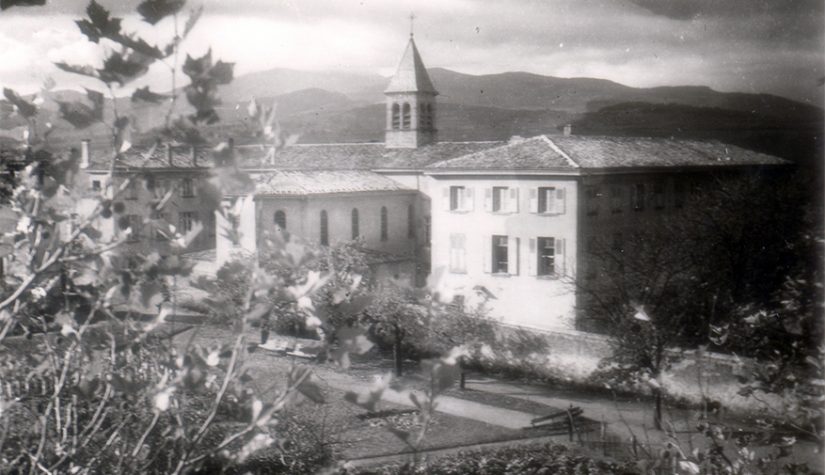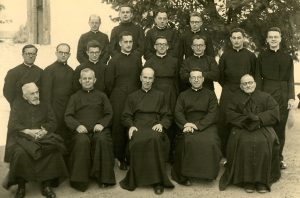About Us
History

Founding
The Congregation of St. Basil was born in France in a time of turmoil, revolution and harsh persecution targeting the Catholic Church. After the revolution, in 1790, all religious orders were abolished. Clergy became employees of the state and forced to take an oath of loyalty that would override the authority of the Pope. Those who refused to take the oath were sent to the guillotine. This period became known as the Reign of Terror during which over 30,000 French citizens were publicly executed; priests and seminarians were imprisoned and massacred; and churches were destroyed.
In 1797, Archbishop Charles-François d’Aviau of Vienne returned to France after fleeing the Reign of Terror and asked Father Joseph Lapierre to open a clandestine seminary school in the southern French region of Ardèche, in the village of Saint-Symphorien-de-Mahun. In 1802, a year after the Church reached a Concordat with the Emperor Napoleon, the tiny school moved to the town of Annonay, where the population of about 5,000 could support the growth that was expected. Despite ongoing political pressure and persecution to make history classes “politically correct”, the school in Annonay flourished and by 1813, two more schools opened: Ste. Barbe and Ste. Claire. The schools became known for their exceptional range of teaching including humanities, rhetoric, philosophy, mathematics, physics and chemistry. The teacher-priests devoted themselves to Christian education, preaching, and life in community.
After several years of operation, the Annonay teachers put forward a proposal to the Bishop that they form an association or society. These men became the founding fathers of the Congregation of St. Basil. On November 21, 1822, on the feast of the Presentation of Our Lady, the ten founders chose Father Joseph Lapierre as the first superior general and St. Basil as the patron for the order.
After 1822, the Basilians were not yet a religious congregation in the canonical sense. Instead it was a loose association of secular priests willing to live in community and pool their resources to support Christian education. Membership in the association shared by those who lived in the community and taught at the schools and there were no formal religious vows.
Arrival in the New World
In 1850, Bishop Armand de Charbonnel, a former Basilian student in Annonay from 1811 to 1819, was named the Archbishop of Toronto. He invited the French Basilians to come to Canada to establish a school for the Irish Catholic community in Toronto. The Basilians sent four priests, a significant percentage of the total number of available priests at the time. This decision represented a huge sacrifice and risk for the Congregation. In 1852, St. Michael’s College opened its doors, offering in the French style, a combination of high school and university education.
The Basilians came to the aid of various Bishops who needed Christian educators in both France and the New World. They established schools and seminaries across North America including Owen Sound, Ontario (1863), Blidah, Algeria (1868), Sandwich, (now Windsor) Ontario (1870), Amherstburg, Ontario (1878), Beaconsfield, England (1883), Detroit, Michigan (1886), Waco, Texas (1899) Houston, Texas (1900), LaPorte, Texas (1901), and Chatham, New Brunswick (1910).
However in France, Catholic schools were once again the target of the government’s anticlerical agenda. In 1881, Basilians were forced to close one of their schools. By 1904, all religious congregations were suppressed; many French Basilians became secular priests while others were dispersed to Italy and England. Basilian property was sold at auction. There were 90 Basilian confrères in France at the time and the religious life of the community was suspended until the end of the First World War in 1918.
Decree of Amicable Separation of 1922 and Reunification
Tensions, both canonical and political, between the New World Basilian councilors and the French leadership of the Congregation resulted in an amicable Decree of Separation in June of 1922 and the outcome was two distinct congregations: the Basilian Fathers of Viviers and the Basilian Fathers of Toronto. At its first General Chapter in 1922, the Basilian Fathers of Toronto voted in favour of becoming a religious congregation with vows of simple poverty.
T he newly founded North American congregation enjoyed rapid growth. They established a new presence in Rochester, New York in 1937 and Saskatoon, Saskatchewan in 1936. In 1942 there were 171 priests, by 1954 there were 312 priests, and in 1964 there were 478 priests. This period of growth was also marked by the establishment of new schools including the University of St. Thomas in Houston, Texas in 1947; St. John Fisher College in Rochester, New York in 1951; St. Charles College in Sudbury, Ontario in 1951; and St. Mark’s College in Vancouver, British Columbia in 1951.
he newly founded North American congregation enjoyed rapid growth. They established a new presence in Rochester, New York in 1937 and Saskatoon, Saskatchewan in 1936. In 1942 there were 171 priests, by 1954 there were 312 priests, and in 1964 there were 478 priests. This period of growth was also marked by the establishment of new schools including the University of St. Thomas in Houston, Texas in 1947; St. John Fisher College in Rochester, New York in 1951; St. Charles College in Sudbury, Ontario in 1951; and St. Mark’s College in Vancouver, British Columbia in 1951.
In 1955, under the leadership of Father George Bernard Flahiff, CSB, who would later become Cardinal Archbishop of Winnipeg, the Congregation celebrated the reunion of the French and North American Basilians.
Latin American Apostolates
Thanks to the large number of priests available in a post WWII world, the Basilians continued their growth with missions to Mexico in 1961 and Colombia in 1987. The mission work in Mexico was a natural extension of their existing work with the Mexican-American population in South Texas since the 1930s. The desire to establish a center of education in Latin America led the Basilians to take over a school and parish in Cali, Colombia. Since then, they have expanded their ministry to Bogotá and Medellín.
Throughout their history, Basilians have willingly and repeatedly taken risks that threaten the future of the Congregation and they continue to make these courageous choices to meet the needs of those they serve.